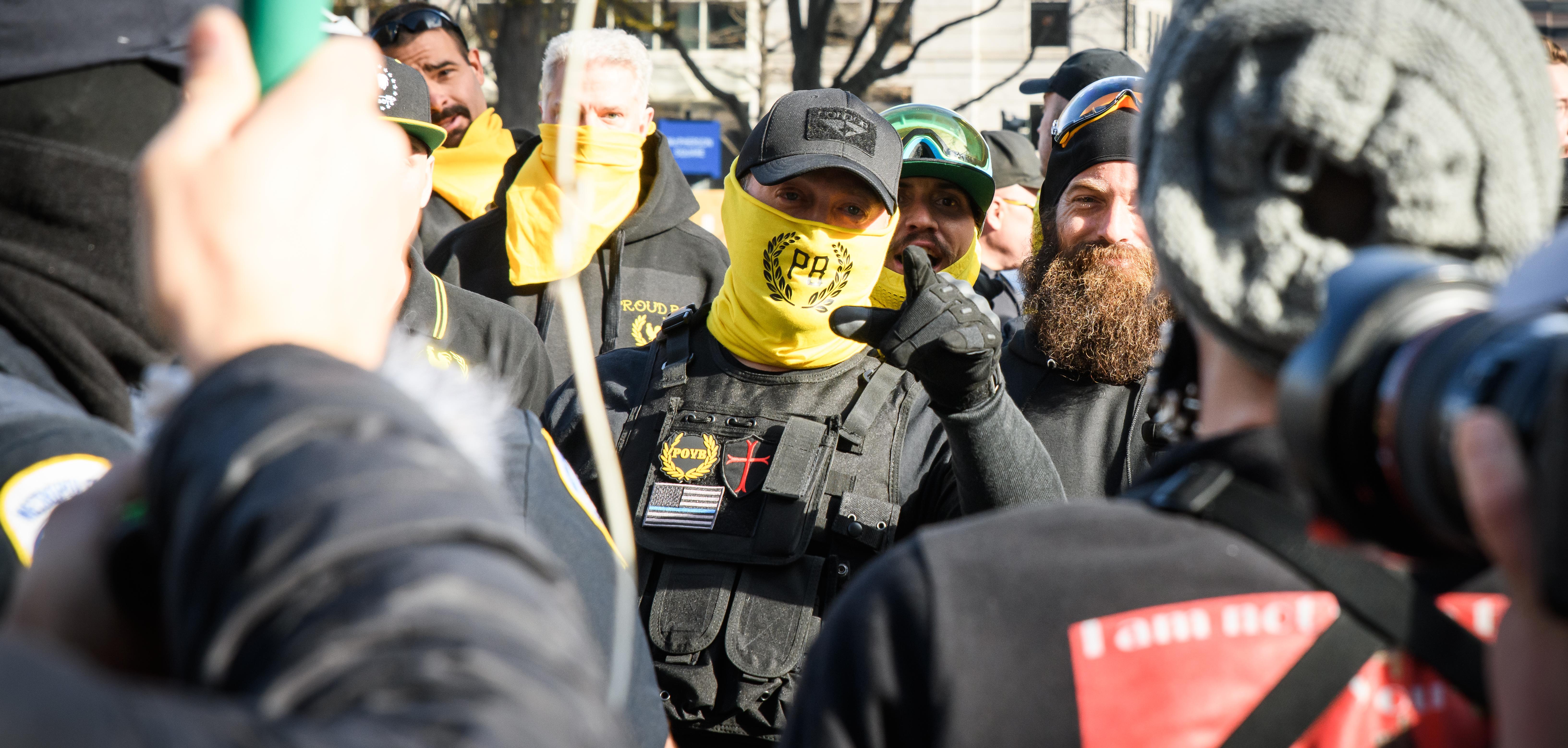On August 17, 2019, the Proud Boys staged a rally against “domestic terrorism” in Portland, Oregon, allegedly in response to a prior scuffle between far-right media personality Andy Ngo and counter-demonstrators who were opposing the Proud Boys and the Christian nationalist group Patriot Prayer. Hundreds of Proud Boys flew in from around the country for the rally, and lined up a block deep, carrying weapons and tactical gear. When they antagonized the growing counter-demonstration, the Portland police protected them, escorting them across a bridge and away from counter-demonstrators they’d provoked.
Despite the irony of one of the most violent domestic far-right groups in the U.S. posing as the line of defense against terrorism, this was standard fare for Portland. Since 2016, Portland’s city center has been the site of numerous high-profile, violent clashes. The summer of 2018 was marred by incredibly bloody fights, captured in videos that became infamous, wherein Proud Boys led gang-style assaults on demonstrators, causing serious injuries. Patriot Prayer’s founder Joey Gibson, who is not from Portland, built his brand, and even a failed Senate run, on this sort of spectacle, staging political rallies in liberal cities to provoke a reaction from the Left. And throughout these rallies, law enforcement has seemed unable, or unwilling, to intervene against the far-right demonstrators, and instead focused on using flash grenades, tear gas, and baton swings on antifascists.

It was at the notorious August 2019 clash where I first met Andy Campbell, a Huffpost reporter who is part of the small cohort of journalists and researchers who primarily cover the Far Right, and one of the most dependable writers on the beat. In his 2022 book, We Are Proud Boys: How a Right-Wing Street Gang Ushered in a New Era of American Extremism, Campbell crafts a comprehensive and compelling history of one of the most dangerous far-right movements in the 21st Century. Chronicling the group from its founding by far-right media personality Gavin McInnes, Campbell identifies brutality as a core component of the group’s mission, explaining how the Proud Boys intended from their outset to return violence to politics and act as enforcers for the evolving political Right.
Throughout the book, Campbell profiles key characters, like Ethan “Rufio Panman” Nordean, a Washington state-based Proud Boy who became a hero on the Far Right for knocking out an antifascist counter-protester in a video that played on repeat across far-right social media. Nordean, Campbell explains, is representative of the Proud Boys’ self-appointed leadership caste, whose recorded stunts, threats, and bullying make them stars, and in turn attract a flood of new member applications. This is part of the paradox that Campbell discusses throughout the book: how the group’s most unhinged, chaotic, and illegal behavior draws waves of new recruits, even as those antics have left the organization constantly teetering on the edge of collapse.
What may be most pertinent in We Are Proud Boys is the fact that, unlike White nationalist Hard Right groups like the American Identity Movement or neonazi organizations like the Traditionalist Worker Party, the Proud Boys have successfully made inroads with the GOP, acting as the street-level muscle for Republicans’ new political brand. As the party shifts further into far-right territory, with the elevation of figures like Rep. Marjorie Taylor Greene, the Proud Boys have cultivated powerful connections with figures across the conservative movement. Conspiracy theories about antifa help bind this alliance together, presenting a manufactured boogeyman that can justify the Proud Boys’ violence. Police neutrality likewise grants them protection in the street conflicts they initiate, while online celebrity and monetization funds their activities. Although there have been some serious legal consequences for a few Proud Boys before the January 6th convictions—such as as the four year sentences handed down to two Proud Boys for attacking antifascists outside of a Republican event where founder Gavin McInnes spoke—there are many more who have participated in Proud Boy-related crimes that will never be prosecuted. And, as Campbell makes clear, without the Proud Boys’ rise and ingratiation within conservative circles, the January 6 insurrection may never have been possible.
Since the Jan. 6 riots, the Proud Boys have been thrown into turmoil. On February 3, 2021, the police swarmed Nordean’s home, shattering the illusion that the Proud Boys’ cause came without consequences. But, as Campbell illustrates, their dissolution is not likely. The Proud Boys have survived other incidents that could have eradicated their organization and have continued to ride the wave of a mutating right wing.
The implications of Campbell’s book are more global than just the Proud Boys’ movement. Around the world, societies are shifting from a period in which political battles were fought through “soft power” negotiations within democratic systems to one where violence is more and more likely. As crises pervades our climate, economy, and political system, right-wing politics are pressing against the limits of what elections can deliver, and the Right is hoping to channel working class instability into populist nativism rather than legitimate class struggle. Now Republican leaders are increasingly willing to suggest that “hard power” could be necessary to claim victories by force—another legacy of the Proud Boys, following McInnes’ mantra, “Violence solves everything.”
The Proud Boys remain one of the primary fascist threats in the U.S., but they are merely one local force in a confederation of far-right enforcers seeking to re-establish street violence as the means of excluding whoever doesn’t fit their mold of what an American should be. Everything that defines the Proud Boys—their approach, their seething rage, and entitlement to attack—has become part of our status quo. The only question is, how will it be stopped?

